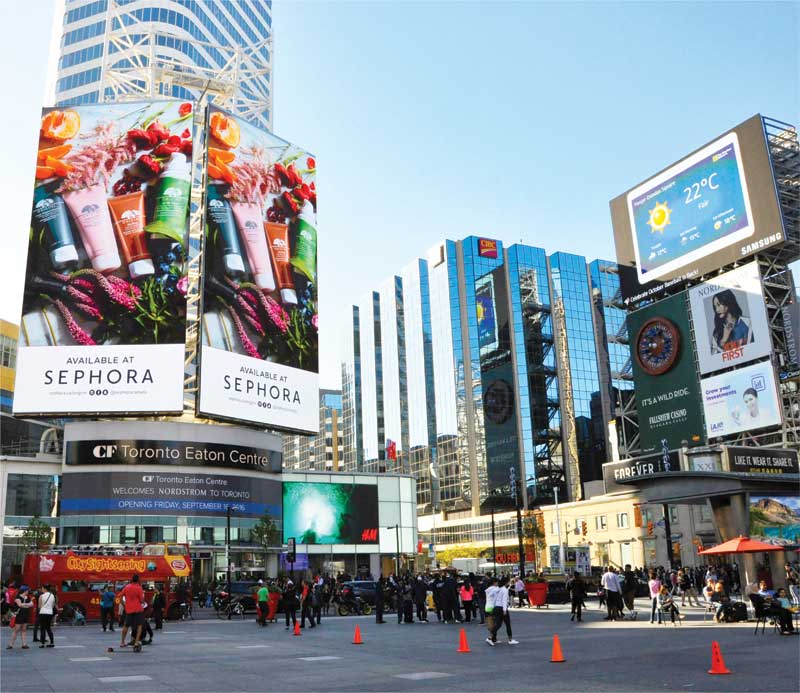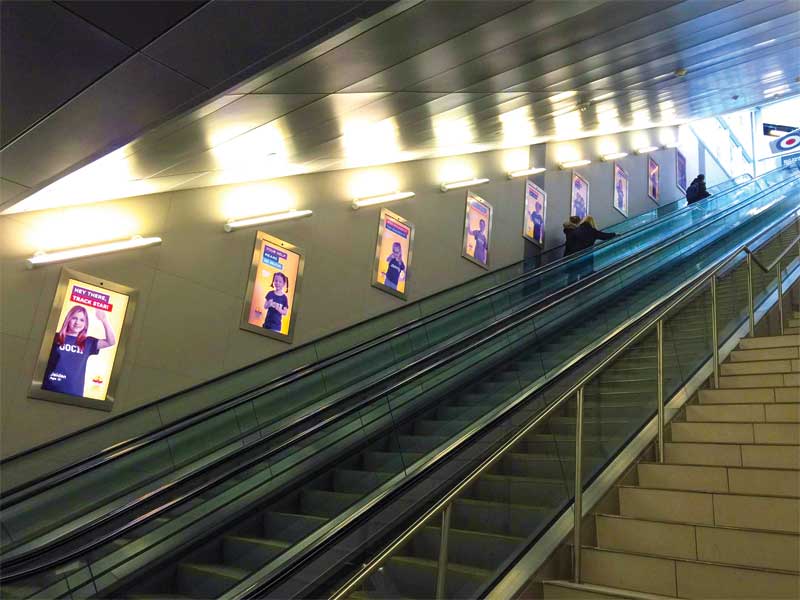The evolution of out-of-home media
by | 11 December 2018 5:30 pm
By Andy McRae
 [1]
[1]
Consumers are spending more and more time out of their homes working, shopping, and playing. According to the Outdoor Advertising Association of America (OAAA), as much as 70 per cent of their waking hours are spent away from home. To reach this increasingly transient population, marketers and advertising are increasingly turning to out-of-home (OOH) media. To better handle that demand and offer better campaigns, the OOH industry is in the midst of a dramatic shift to digital technology, enabling advertisers to create campaigns that are highly targeted, interactive, and offer intelligent content based on an ever-growing mountain of actionable data.
In this age of personal video recorders (PVRs), dwindling newspaper subscriptions, increased use of public transportation, and heavy reliance on mobile devices, OOH and digital out-of-home (DOOH) are becoming an important part of the media mix. Digital screens and signs are capable of influencing destination decisions, educating people on the launch of new products and services, and providing viewers with valuable information relevant to their surroundings without being able to change the channel.
It is an exciting time for the industry, as it is catching the attention of companies like Amazon, Google, Microsoft, and Netflix. Despite the rosy outlook, however, there are some challenges and growing pains that need to be overcome.
Plenty of growth and opportunity
 [2]
[2]The creative teams at Adams + Fairway understand the power of dynamic digital out-of-home (DOOH). Dot2Dot works with Adams + Fairway to provide contextually relevant content.
The DOOH industry, with its wide range of deployments, diverse venues, and multiple formats continues to enjoy unprecedented growth. There are an estimated 10,000-plus networks across North America playing tens of millions of spots daily. The category has expanded from billboards and bus shelters to include small format units in transportation hubs, malls, stores, hotels, casinos, and anywhere people pass or gather.
Initially, these were static analogue signs; however, they have now become interactive with the capability of responding to people walking by or as they pass in their vehicles. As stated by Alan High in his article, “Revenue Road Map for DOOH Deployments,” estimated advertising revenues in 2017 were more than $2 billion, with a sustained eight to 10 per cent annual growth rate forecast over the next five years.
The global DOOH market is expected to get bigger at a compound annual growth rate of 12.6 per cent from 2017 to 2023, reports Allied Market Research. It also predicts the market will reach more than $8 billion within the next five years.
The billboard segment held the highest market share in 2016 and will continue to grow by 12.8 per cent from 2017 to 2023. Europe will continue to hold the highest market share at 32.7 per cent, because of the high demand for digital signage across multiple verticals.
That said, sign industry professionals must ask themselves: how can they capitalize on this spectacular demand, while at the same time satisfy their buyers’ demands of immediacy, relevancy, simplicity, transparency, and most importantly, return on investment (ROI)?
Getting the most out of DOOH
 [3]
[3]The industry is also seeing more and more networks who are adding non-advertising content to their screens as a means of creating some context and giving viewers more reason to look.
Digital inherently solves the issue of immediacy. It is possible to create, schedule, and display content in a fraction of the time of traditional OOH. It is also becoming almost commonplace for digital locations to house multiple versions of content and use various triggers to determine which content to play. Understanding those triggers and the contributing factors that lead someone to react to an ad in the desired manner is the key to relevance.
If one is to believe content is ‘king’ then it must follow that context is ‘queen.’ If it is possible to be aware of not only how many people are in front of a particular screen, but also who they are and why they are there, better decisions can be made on what content to present. The industry is also seeing more and more networks who are adding non-advertising content to their screens as a means of creating some context and giving viewers more reason to look. News feeds, weather, traffic, events, and live-streaming are all good examples. Social media feeds give viewers a chance to participate in the process by posting their feedback or taking part in an activity.
Buying DOOH, data, and the lack of standards
Simplicity is proving to be more difficult to master as the process becomes increasingly complex. It is true content management systems (CMSs) and media management platforms are becoming more sophisticated and automated. This is not enough, however. Buyers want to buy DOOH in a manner similar to how online media is purchased. General circulation used to be the currency of OOH, but DOOH buyers want to purchase targeted impressions. This has led to programmatic buying becoming the most talked about trend in DOOH in the last six to 12 months.
It is certainly a wonderful goal to make DOOH easier to buy, more targeted, more immediate, and much more flexible. Being able to buy based on budget, audience characteristics, actual views, time, number of plays, and more, instead of just buying a percentage of the general population is attractive. In fact, being able to buy it directly for a lower cost makes it very attractive.
 [4]
[4]At Toronto’s Billy Bishop Airport, BLACK Digital Media uses Dot2Dot’s technology to run their advertising network and flight information display system (FIDS).
Programmatic is not without its issues, however, as OOH and DOOH have always been a mass media. The opportunity is to communicate with many, not with one. The programmatic systems developed for other media have been focused on clicks by individuals who fit a particular profile or are searching for a particular product or service. As these people are online, the inventory is unlimited. DOOH operates on a fixed capacity and is still measured by total audience, even if it is broken down into profiles.
There have also been concerns about the data collected and how it is used as the basis of targeting, not the least of which is privacy. Finally, and perhaps most difficult, is the lack of standards and the sheer number of variations in the inventory making it difficult to easily push content across multiple networks. In order for this to be fully accepted, the industry needs to provide advertisers the transparency they are demanding on the data validity.
As a first step, many DOOH providers are considering hosting their own private exchanges to give customers all the demographic targeting they desire, along with fixed formats and standards, as well as flexibility in scheduling all while not ceding control of their inventory to a third party.
Where the fun really kicks in
Expanding the digital network to mobile devices through the use of retargeting, beacons, or even QR codes is empowering advertisers to get the benefits of one-to-many and also one-to-one. Technology that allows advertisers to track cell phone data to determine whether a viewer is a new impression or a return visitor, along with how long they stay in front of the sign, also helps to refine the message. Camera technology helps the operator count people who actually looked at the ad as opposed to those who just walked by. These technologies do not record anything other than the count. There have been many great examples of the content itself directing viewers to a particular micro site where the interaction is personal, which is the best of both worlds.
The return
The final consideration is how to deliver on ROI? DOOH has become relevant and responsive, leveraging technology to make it easier than ever to buy, but is it more valuable? Again, the answer lies in data and analytics. The fact it is possible to determine exactly where and when a particular ad plays or is posted provides part of the answer. Further, the ability to tailor the creative to be most relevant given the immediate circumstances around the location takes it to another level. Finally, having the power to merge the playback and point of sale (POS) data together in a single dashboard can show whether the campaign worked or not. POS data is not always readily available, but certainly is for in-store networks, at least to the advertiser. It is not always about the money though.
It is also important to consider return on objective (ROO) in those cases when it is something other than sales lift. For example, many retailers launch campaigns aimed at increasing the sign-up rate for a loyalty program, as this can be measured as well.
The sign has always been the most effective tool for communicating with each other. The advent of digital has made them even more so. All indications show the industry will continue to enjoy excellent growth as capabilities continue to expand and costs continue to decrease.
Andy McRae is general manager for Dot2Dot Communications, a full-service visual communications company that designs, develops, and manages immersive digital signage experiences. For more information, visit www.dot2dotcommunications.com[5].
- [Image]: https://www.signmedia.ca/wp-content/uploads/2018/12/Branded_Cities_Dundas_Square.jpg
- [Image]: https://www.signmedia.ca/wp-content/uploads/2018/12/Adams_Outdoor_Instagram.jpg
- [Image]: https://www.signmedia.ca/wp-content/uploads/2018/12/Billy_Bishop.jpg
- [Image]: https://www.signmedia.ca/wp-content/uploads/2018/12/Billy_Bishop_Elevator-cc.jpg
- www.dot2dotcommunications.com: https://dot2dotcommunications.com/
Source URL: https://www.signmedia.ca/the-evolution-of-out-of-home-media/